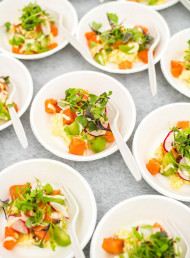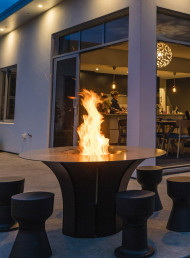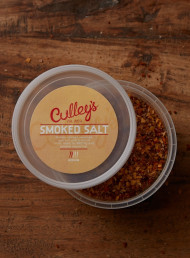A guide to: barbecuing
Photography by Manja Wachsmuth.

As the stunning weather continues, move the kitchen outdoors and fire up the barbecue. Here are our tips for getting the most out of yours...
Cooking over fire has been with us since early man and most countries have developed their own variations on the barbecue or grilling theme; from ‘a la plancha’ in Spain (meaning to grill on a metal plate) to the ‘braai’ of South Africa and Texas-style barbecue in the US. Despite the advances in cooking technology in recent decades we still return to our roots and embrace the evocative delights of cooking over fire.
In New Zealand and Australia barbecuing is a significant part of our cooking culture and we draw on many international cuisines. Our style of outdoor cooking retains a uniquely Antipodean feel too; a barbecue is as much a social occasion as it is a means of cooking food, whether it’s over embers by the beach or on a giant stainless steel 8-burner button-ignition gas barbecue.
The word ‘barbecue’ is believed to derive from the Spanish ‘barbacoa’, meaning a wooden framework for drying meat or fish. Traditional methods involve long, slow, indirect cooking over embers. These days it refers to cooking over both a gas flame and a fire made from wood or charcoal.
While most New Zealanders have some form of barbecue on the back deck or in the garden, councils also provide a great range of gas and wood-fired barbecues for public use in and around our parks and beaches. Contact your local council for details.
TYPES OF BARBECUES
Gas
A popular barbecue for its ease of use and clean-burning fuel. The LPG barbecue can range from a small pedestal-style grill through to an enormous 8 burner mega-barbecue with additional accessories such as built-in woks, bench tops, cupboards and even fridges.
When cooking with gas:
• Ensure you allow enough time for the grill plate to heat before you start to cook.
• Once seared on one side, turn the food over and reduce the flame so that the food cooks through evenly without developing a charred crust or burning.
• Ensure there is an adequate layer of fat absorbing material in the base of the barbecue as this prevents flare ups.
Wood-fired
Aficionados swear by this method of barbecuing as being best for adding flavour to food from wood smoke while you cook, depending on the type of wood used; hardwoods such as hickory and mesquite are popular choices in the US. Wood-fired barbecues are often purpose-built, although there are portable versions, some of which use wood-smoked pellets for fuel.
When cooking over a wood fire:
• Use the densest wood you can find – soft woods like pine will burn too quickly without developing long-lasting embers. Wood from oak, fruit or nut trees work well, or try old grape vine cuttings if you can get them.
• Depending on the size of your fire, you need to light it long enough before you want to start cooking to allow the wood to burn down and create hot embers. Red, glowing embers are perfect for cooking as they give off a lot of heat without flames licking up and charring food.
• Stir the embers while cooking to release more heat as you need it.
• If you need to add more firewood, add it at the side so it can burn down first and then be pushed into the cooking area.
Charcoal
These use charcoal briquettes or natural wood charcoal with the most common style of charcoal barbecue being the ‘kettle grill’. (It takes its name from the lower chamber that holds the charcoal, as it’s shaped like a kettle.) When the lid is closed it helps heat circulate around the food as it cooks and holds in the flavoursome smoke. Smaller portable charcoal grills are also useful for camping or on boats.
When cooking over charcoal:
• Prepare the fire about 30 minutes before you want to start cooking.
• Place the barbecue on a stable, non-flammable surface, in a sheltered place.
• Spread charcoal briquettes over the grate, and use them to build a pyramid in the centre.
• Open the air vent.
• Insert 2 or 3 firelighters into the lower part of the fuel and use long matches to light them.
• The coals will be ready to cook over when the flames have subsided, the coals are covered with grey ash and you can’t hold your hand over them for more than a few seconds. It’s important to ensure the coals have burnt down sufficiently before cooking. If too hot, the food will burn before it is cooked through.
• Spread the coals out evenly and place the grill about 8 cm above them.
• You will have about 30 minutes cooking time from one layer of coals. To cook for longer, add more briquettes, placing them around the edge of the fire.
BARBECUE SAFETY
• Fully defrost meat and fish before cooking. Overnight in the fridge is best, don’t defrost meat in full sunlight.
• Once the barbecue is lit, don’t try to move it.
• If using firelighters make sure you wait at least 15 minutes before cooking, as they release fumes when they first burn.
• Never leave the barbecue unattended.
• Use separate plates for raw and cooked food. Never serve cooked meats in the same dish in which they sat when they were raw.
• Ensure poultry is cooked through and that the juices are clear. Place in a preheated oven to finish cooking if necessary.
• Avoid flare-ups by trimming excess fat from meat and baste with care to ensure oil does not drip onto the heat source. Use a layer of fat absorbing material in the base of the barbecue too.
TOP TIPS FOR BARBECUING
• Have meat at room temperature before cooking for best results.
• Season the food well before cooking.
• A fish grill (usually a fish-shaped wire basket with handles) makes it much easier to turn fish without breaking it.
Before cooking:Make sure you have adequate fuel, gas or charcoal. Don’t risk running out halfway through cooking.
Start with a clean grill. Before cooking, heat the grill and use a wire brush to remove any burnt on food from the previous use.
Oil the grill lightly with vegetable oil if necessary. Use a thickly folded paper towel held with long tongs and dipped in oil. Alternatively, oil the food.
During cooking: Once food is seared and well coloured turn the heat down, or move to a cooler part of the grill to allow it to continue cooking without burning.
Large pieces of meat will cook more evenly when covered. If your barbecue does not have a lid use a wok lid or a large roasting pan, disposable foil ones work well.
Don’t crowd the grill plate or food won’t cook evenly and wil take longer.
Don’t prick meat or fish while cooking (especially true for sausages) or the juice will run out and they will become dry.
Avoid turning the food too often, once should be enough for small items.
Afterwards:Rest meat well once it is removed from the grill – cover loosely with a clean tea towel. This will give a much more succulent result.
Perfect steak:The best beef cuts for barbecuing are T-bone, sirloin, rump and fillet. Season and/or marinade the meat. Oil the grill and start to heat it, wait until it has reached optimum temperature before placing the meat on it. Wait until blood appears on the raw surface of the meat before turning it over. Don’t turn it more than once as this will dry the steak out.
Press gently on the surface of the steak with the end of your barbecue tong to assess its doneness – rare meat will be relatively soft to the touch, whereas medium rare will have just a little give. Remove it from the grill to rest before serving.
Rotisserie: Cooking meat on a rotisserie offers even cooking over low heat. Some barbecues come with built-in rotisseries or you can buy rotisserie sets which fit into your barbecue. They will be either a long skewer, or a skewer with a basket.
Prepare the meat as you would for a roast, then thread onto the rotisserie and cook over a low heat. If you want to caramelize the outside of the meat, start it over a high heat, then reduce and close the lid of the barbecue (if you have one).
ADDING FLAVOUR
Fresh herbs, rubs, simple marinades and glazes or even infused oils are all easy ways of adding flavour to barbecued food.
Herbs
Tie stems of thyme and rosemary together and use as a brush when basting meats or vegetables with oil.
Place fresh herbs such as rosemary, bay or lemongrass on the coals. Soak them in water first, so they burn slowly. Dried grapevines or fennel stalks also add great flavour.
Make aromatic skewers for kebabs using sturdy rosemary stems, lemongrass, or sticks from olive or bay trees. Strip the leaves off and soak the stems in cold water for 30 minutes before using as this prevents them burning while cooking.
Wrapping food
Vegetables and fish are particularly delicious wrapped and cooked on the barbecue. Add lemon and a delicate herb such as thyme or fennel to fish, wrap in aluminium foil and steam.
Or use the wrapping itself to add flavour by using banana leaves (available frozen at Asian food stores), lotus leaves (available dried at Asian food stores) preserved vine leaves, sheets of nori or pandan leaves (available frozen at Asian food stores).
Marinades and glazes
A marinade can be as simple as garlic, salt, pepper, olive oil and a squeeze of lemon juice. Or try an Asian-inspired version with soy sauce, crushed ginger, a dash of Shaoxing Chinese rice wine and
a squeeze of lime juice.
Marinate food in stainless steel, plastic, glass or ceramic bowls, never copper or aluminium as these can react with some of the acids in the marinades and affect the flavour.
Baste the food with the marinade or glaze while cooking – but apply glazes and sauces with high sugar content only during the last 10-15 minutes
of cooking, to avoid burning.
Jerk Marinade
½ small red onion, chopped
1 long red chilli or ½ teaspoon chilli flakes
1 tablespoon grated ginger
2 teaspoons thyme leaves
2 cloves garlic, chopped
zest and juice of 1 lime
½ teaspoon each ground allspice, cinnamon, freshly grated nutmeg
1 tablespoon each brown sugar, soy sauce, vegetable oil
Combine all the marinade ingredients in a blender and process until smooth. Store in the refrigerator for up to a week. Makes ½ cup
Rubs and oils
There is a great range of locally made rubs, many using indigenous herbs such as kawakawa or horopito, available from gourmet food stores and good supermarkets. Simply oil the meat, poultry or fish and sprinkle with the rub, pressing it in gently. Or make your own by pounding dried herbs, salt and pepper in a mortar and pestle.
Infused oils are also ideal for adding flavours such as lemon, chilli or fennel to meats. You can buy these from food stores or supermarkets or infuse the oil yourself. Simply brush over the items you’re cooking.
The rubs below can be stored in tightly sealed jars.
Moroccan Rub
Try this rub or the Indian version below with chicken or lamb, or toss them with sliced eggplant, red capsicum, tomatoes and red onions and a little oil before roasting.
3 tablespoons coriander seeds
3 tablespoons cumin seeds
3 tablespoons black peppercorns
3 tablespoons paprika
1 tablespoon cinnamon
Toast the coriander, cumin and peppercorns individually in a small skillet until fragrant. Combine with the paprika and cinnamon and grind in a spice grinder until finely ground. Makes approximately 1 cup
Indian Rub
4 tablespoons fennel seeds
4 tablespoons ground cumin
4 tablespoons ground cardamom
4 teaspoons ground coriander
4 teaspoons dry mustard
2 teaspoons ground cinnamon
1 teaspoon ground cloves
2 tablespoons brown sugar
Grind the fennel seeds in a spice grinder and combine with the remaining ingredients. Makes approximately 1 cup
Juniper and Herb Rub
This rub is delicious with pork or venison, and with game birds like quail or duck.
6 tablespoons juniper berries
2 tablespoons dried rosemary
3 teaspoons dried thyme
1½ teaspoons ground allspice
3 teaspoons sea salt
3 teaspoons brown sugar
Grind together the juniper berries, rosemary and thyme. Combine with the remaining ingredients. Makes approximately ¾ cup
latest issue:
Issue #120
As the days become shorter, and the nights cooler, the latest issue is perfectly timed to deliver delicious autumn dishes. From recipes using fresh seasonal produce such as feijoas and apples, to spectacular soothing soups and super-quick after-work meals in our Food Fast section, we’ve got you covered. With Easter on the horizon, we feature recipes that will see you through breakfast, lunch and dinner over a leisurely weekend holiday, and whip up chocolatey baking treats sure to please. We round up delicious dinners for two and showcase a hot new Korean cookbook before heading south to Dunedin to check out all that’s new in food and dining.The latest issue of dish is on sale NOW at all good bookstores and supermarkets – don’t miss it!





